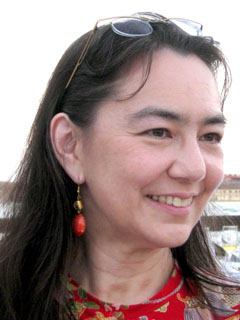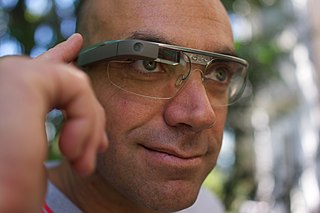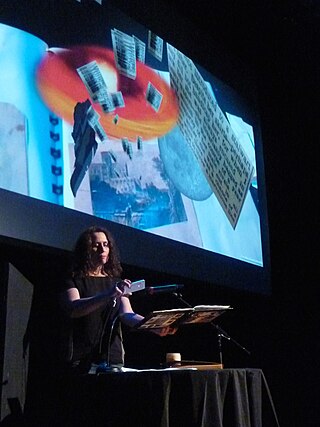
Augmented reality (AR) is an interactive experience that combines the real world and computer-generated 3D content. The content can span multiple sensory modalities, including visual, auditory, haptic, somatosensory and olfactory. AR can be defined as a system that incorporates three basic features: a combination of real and virtual worlds, real-time interaction, and accurate 3D registration of virtual and real objects. The overlaid sensory information can be constructive, or destructive. As such, it is one of the key technologies in the reality-virtuality continuum.

Digital art refers to any artistic work or practice that uses digital technology as part of the creative or presentation process. It can also refer to computational art that uses and engages with digital media. Since the 1960s, various names have been used to describe digital art, including computer art, electronic art, multimedia art, and new media art.

Mixed reality (MR) is a term used to describe the merging of a real-world environment and a computer-generated one. Physical and virtual objects may co-exist in mixed reality environments and interact in real time.

The OpenIllusionist Project is a computer program for the rapid development of augmented reality applications. OpenIllusionist provides software libraries to make easier the tasks of generating these images, performing the necessary computer vision tasks to interpret the user input, modelling the behaviour of any of the virtual objects, and threading all of the above to provide the illusion of reality.
Locative media or location-based media (LBM) is a virtual medium of communication functionally bound to a location. The physical implementation of locative media, however, is not bound to the same location to which the content refers.
Craig Saper is a Professor of Language, Literacy, & Culture at the University of Maryland Baltimore County (UMBC).

In virtual reality (VR), immersion is the perception of being physically present in a non-physical world. The perception is created by surrounding the user of the VR system in images, sound or other stimuli that provide an engrossing total environment.
A projection augmented model is an element sometimes employed in virtual reality systems. It consists of a physical three-dimensional model onto which a computer image is projected to create a realistic looking object. Importantly, the physical model is the same geometric shape as the object that the PA model depicts.
Gregory Peter Panos is an American writer, futurist, educator, strategic planning consultant, conference / event producer, and technology evangelist in augmented reality, virtual reality, human simulation, motion capture, performance animation, 3D character animation, human-computer interaction, and user experience design.

Lawrence Jay Rosenblum is an American mathematician, and Program Director for Graphics and Visualization at the National Science Foundation.

Craig Barron is an American visual effects artist and creative director at Magnopus, a media company that produces visual development and virtual production services for motion pictures, television, museums and multimedia platforms.
Metaio GmbH was a privately held augmented reality (AR) company that was acquired by Apple Inc. in May 2015. Headquartered in Munich, Germany, with subsidiaries in San Francisco, California, New York City, New York, and Dallas, Texas, Metaio provided a software development kit (SDK) for programming PC, web, mobile applications, and custom offline augmented reality applications. Additionally, Metaio was the creator of Junaio, a free mobile AR browser available for Android and iOS devices.
WebAR, previously known as the Augmented Web, is a web technology that allows for augmented reality functionality within a web browser. It is a combination of HTML, Web Audio, WebGL, and WebRTC. From 2020s more known as web-based Augmented Reality or WebAR, which is about the use of augmented reality elements in browsers.

Tamiko Thiel is an American artist, known for her digital art. Her work often explores "the interplay of place, space, the body and cultural identity," and uses augmented reality (AR) as her platform. Thiel is based in Munich, Germany.

Smartglasses or smart glasses are eye or head-worn wearable computers. Many smartglasses include displays that add information alongside or to what the wearer sees. Alternatively, smartglasses are sometimes defined as glasses that are able to change their optical properties, such as smart sunglasses that are programmed to change tint by electronic means. Alternatively, smartglasses are sometimes defined as glasses that include headphone functionality.
A transreality game, sometimes written as trans-reality game, describes a type of video game or a mode of gameplay that combines playing a game in a virtual environment with game-related, physical experiences in the real world and vice versa. In this approach a player evolves and moves seamlessly through various physical and virtual stages, brought together in one unified game space. Alongside the rising trend of gamification, the application of game mechanics to tasks that are not traditionally associated with play, a transreality approach to gaming incorporates mechanics that extend over time and space, effectively playing through a players day-to-day interactions.
Patrick Lichty is a conceptual media artist, activist, curator, and educator. Lichty is currently a Creative Digital Media professor at Winona State University.
Commercial augmented reality (CAR) describes augmented reality (AR) applications that support various B2B (Business-to-Business) and B2C (Business-to-Consumer) commercial activities, particularly for the retail industry. The use of CAR started in 2010 with virtual dressing rooms for E-commerce.
Nancy Baker Cahill is an American new media artist based in Los Angeles, California. She has created immersive augmented reality (AR) and virtual reality (VR) experiences, video installations and blockchain projects, oftentimes rooted in drawing. Her work frequently merges technology and public art, drawing upon both feminist land art and the history of political interventions to examine systemic power, body autonomy, civics and climate crisis, among other issues.

Caitlin Fisher is a Canadian media artist, poet, writer, futurist and Professor of Cinema and Media Arts at York University in Toronto where she also directs the Immersive Storytelling Lab and the Augmented Reality Lab. Fisher is also a Co-founder of York’s Future Cinema Lab, former Fulbright and Canada Research Chair, and an international award-winning digital storyteller. Creator of some of the world’s first AR poetry and long-from VR narratives. Pioneer of research-creation who defended Canada's first born-digital dissertation. Member of the early AR artist collective Manifest AR. Fisher is also known for the 2001 hypermedia novel These Waves of Girls, and for her work creating content and software for augmented reality. "Her work is poetic and exploratory, currently combining the development of authoring software with evocative literary constructs."















